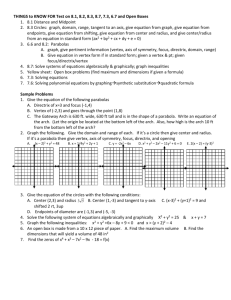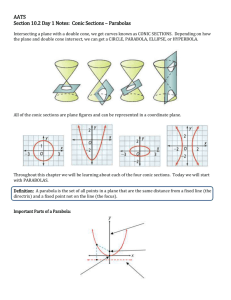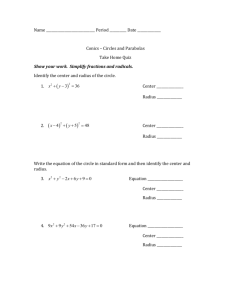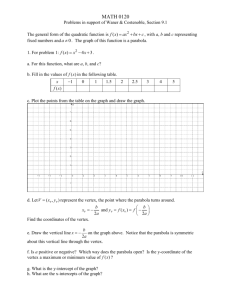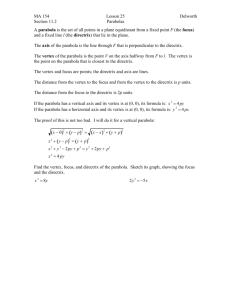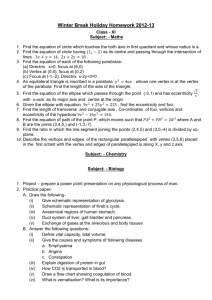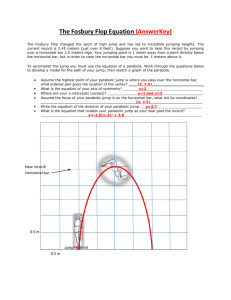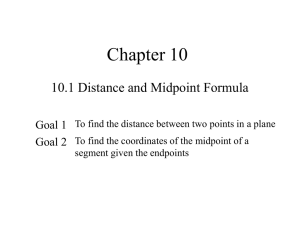Module 7 Lesson 1 Notes Part 2 Parabolas
advertisement
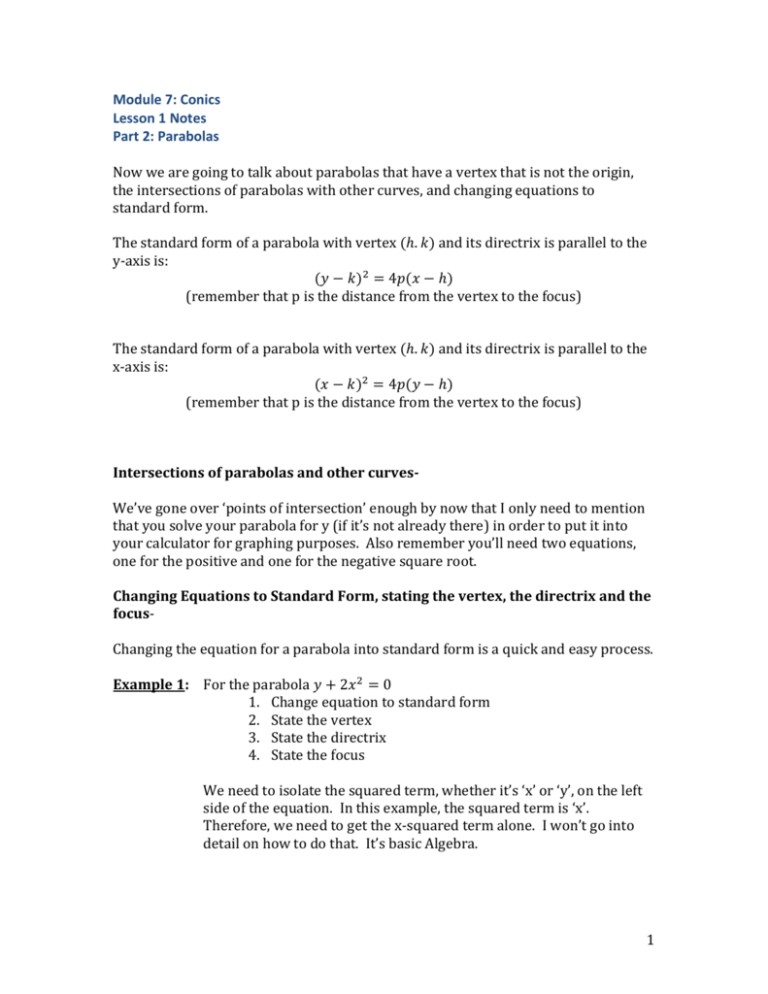
Module 7: Conics Lesson 1 Notes Part 2: Parabolas Now we are going to talk about parabolas that have a vertex that is not the origin, the intersections of parabolas with other curves, and changing equations to standard form. The standard form of a parabola with vertex (ℎ. 𝑘) and its directrix is parallel to the y-axis is: (𝑦 − 𝑘)2 = 4𝑝(𝑥 − ℎ) (remember that p is the distance from the vertex to the focus) The standard form of a parabola with vertex (ℎ. 𝑘) and its directrix is parallel to the x-axis is: (𝑥 − 𝑘)2 = 4𝑝(𝑦 − ℎ) (remember that p is the distance from the vertex to the focus) Intersections of parabolas and other curvesWe’ve gone over ‘points of intersection’ enough by now that I only need to mention that you solve your parabola for y (if it’s not already there) in order to put it into your calculator for graphing purposes. Also remember you’ll need two equations, one for the positive and one for the negative square root. Changing Equations to Standard Form, stating the vertex, the directrix and the focusChanging the equation for a parabola into standard form is a quick and easy process. Example 1: For the parabola 𝑦 + 2𝑥 2 = 0 1. Change equation to standard form 2. State the vertex 3. State the directrix 4. State the focus We need to isolate the squared term, whether it’s ‘x’ or ‘y’, on the left side of the equation. In this example, the squared term is ‘x’. Therefore, we need to get the x-squared term alone. I won’t go into detail on how to do that. It’s basic Algebra. 1 y 2 x2 0 2 x2 y 1 x2 y 2 In the above example, we’d change the equation to: We need to factor a ‘4’ out of the right side. Because standard form has a 4, we always need to factor out a 4 from whatever is in front of the ‘y’. To do this, we simply take whatever number is in front of the ‘y’ and divide it by 4. This will be the number left in front of the ‘y’. 1 y 2 1 x 2 4( ) y 8 x2 1 1 Since: 4 , we now write our equation as: 2 8 1 The Standard Equation for this parabola is 𝑥 2 = 4 (− 8) 𝑦 The vertex is (0,0). 1 The directrix is 𝑦 = 8 The focus is (0, −1 8 ) This was just an example to warm-up because the vertex was the origin. Example 2: For the parabola 𝑦 2 + 8𝑥 − 8 = 0 1. Change equation to standard form 2. State the vertex 3. State the directrix 4. State the focus y 2 8x 8 0 y 2 8 x 8 y 2 8 x 8 y 2 4( 2 x 2) Notice in this equation that we can’t simply write: 4( 2)( x ) because of that extra two at the end. At this point, we need to factor once more. This time, we’re factoring out the coefficient in front of the variable. The coefficient in front of the variable is -2. 2 y 2 = -8x + 8 y 2 = 4(-2x + 2) y 2 = 4(-2)(x - 1) The Standard Equation for this parabola is 𝑦 2 = 4(−2)(𝑥 − 1) The vertex is (1,0). The directrix is 𝑥 = 3 (in part 1 of the notes the directrix was the opposite of the “p” value, since the vertex has shifted away from the origin, you must add the opposite of “p” to the x coordinate of the vertex. ) The focus is (−1,0) (remember that the p value is the distance from the vertex to the focus so you find the focus by (1 − 2,0) which would be (−1,0) Example 3: For the parabola 6𝑥 2 − 2𝑦 − 12 = 0 1. Change equation to standard form 2. State the vertex 3. State the directrix 4. State the focus 6 x 2 2 y 12 0 6 x 2 2 y 12 2 12 y 6 6 1 x2 y 2 3 x2 We’ll need these calculations to move to the next step: 1 1 4 3 12 1 24 2 1 y2 3 1 1 x 2 4( y ) 12 2 x2 We’ll need this calculation to move to Step 3: 1 1 1 12 6 2 12 2 3 1 1 y ) 12 2 1 x 2 4( )( y 6) 12 x 2 4( We now have the equation in standard form. p 1 , the vertex is at (0, -6) 12 1 The Standard Equation for this parabola is 𝑥 2 = 4 (12) (𝑦 + 6) The vertex is (0, −6). −73 The directrix is 𝑦 = 12 (in part 1 of the notes the directrix was the opposite of the “p” value, since the vertex has shifted away from the origin, you must add the 1 −73 opposite of “p” to the y coordinate of the vertex 𝑦 = −6 − 12 which would be 𝑦 = 12 The focus is (0, −71 12 ) (remember that the p value is the distance from the vertex to 1 the focus so you find the focus by (0, −6 + 12)which would be (0, −71 12 ) Example 4: For the parabola 𝑥 2 + 8𝑥 − 3𝑦 − 2 = 0 1. Change equation to standard form 2. State the vertex 3. State the directrix 4. State the focus 5. Verify that this is a parabola 𝑥 2 + 8𝑥 − 3𝑦 − 2 = 0 𝑥 2 + 8𝑥 = 3𝑦 + 2 2 𝑥 + 8𝑥 + 16 = 3𝑦 + 2 + 16 (𝑥 + 4)2 = 3𝑦 + 18 Complete the square with the x squared term 3 18 (𝑥 + 4)2 = 4 ( 𝑦 + ) 4 4 Factor out a 4. 3 18 (𝑥 + 4)2 = 4 ( 𝑦 + ) 4 4 Factor out a 4 3 3 (𝑥 + 4)2 = 4 ( ) (𝑦 + 6) 4 4 3 We now have the equation in standard form 𝑝 = 4 , the vertex is at (-4,-6) 3 The Standard Equation for this parabola is (𝑥 + 4)2 = 4 (4) (𝑦 + 6) The vertex is (−4, −6). −27 The directrix is 𝑦 = 4 (in part 1 of the notes the directrix was the opposite of the “p” value, since the vertex has shifted away from the origin, you must add the 3 −27 opposite of “p” to the y coordinate of the vertex 𝑦 = −6 + 4 which would be 𝑦 = 4 The focus is (−4, −21 4 ) (remember that the p value is the distance from the vertex to 3 the focus so you find the focus by (−4, −6 + 4)which would be (0, −21 4 ) To verify that this is a parabola, put the equation in the Standard form of a Conic and find the discriminant 𝑥 2 + 8𝑥 − 3𝑦 − 2 = 0 𝐴 = 1 𝐵 = 0 𝑎𝑛𝑑 𝐶 = 0 2 𝐵 − 4𝐴𝐶 = 02 − 4(1)(0) = 0 Since the discriminant is 0, this verifies that this is a parabola. 5
